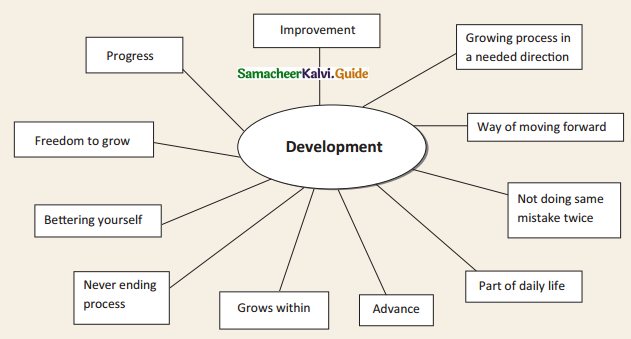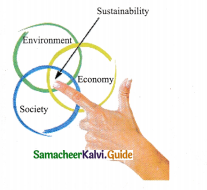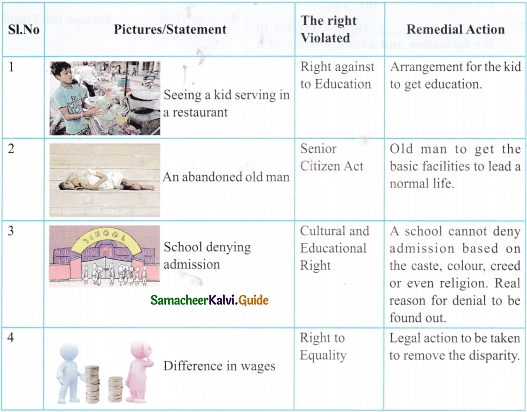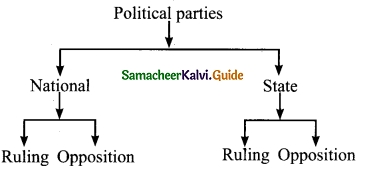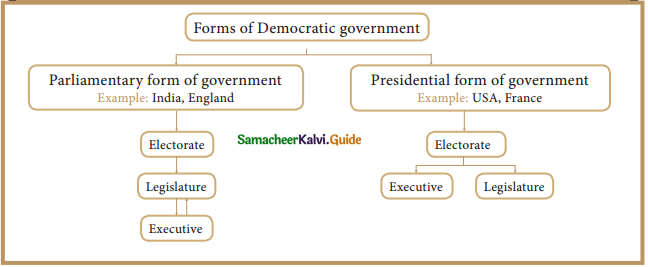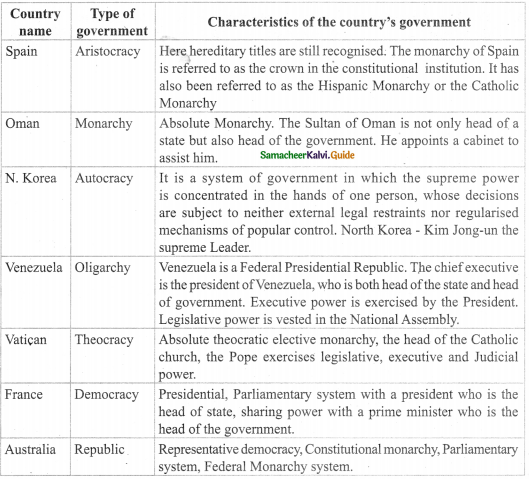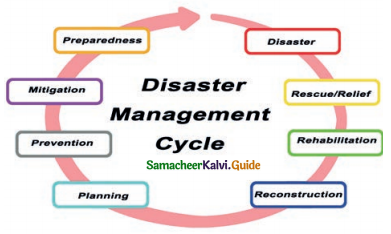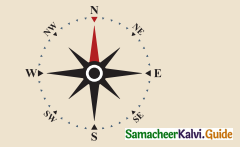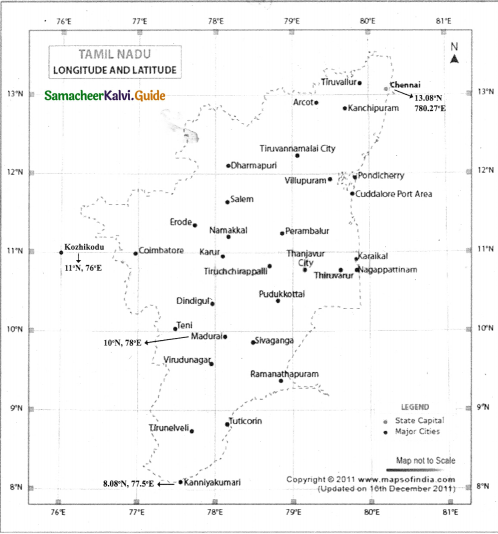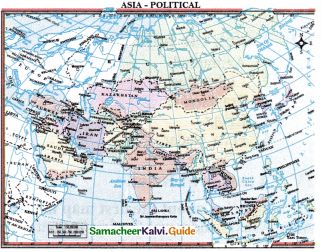Tamilnadu State Board New Syllabus Samacheer Kalvi 9th Social Science Guide Pdf Economics Chapter 2 Employment in India and Tamilnadu Text Book Back Questions and Answers, Important Questions Notes.
Tamilnadu Samacheer Kalvi 9th Social Science Solutions Economics Chapter 2 Employment in India and Tamilnadu
Samacheer Kalvi 9th Social Science Employment in India and Tamilnadu Text Book Back Questions and Answers
I. Choose the correct answer
Question 1.
We take age group ______ years for computation of the workforce.
(a) 12 – 60
(b) 15 – 60
(c) 21 – 65
(d) 5 – 14
Answer:
(b) 15 – 60
![]()
Question 2.
Which is the correct sequence of various sectors in GDP of India in the descending order?
(a) Primary sector, Secondary sector, Tertiary sector
(b) Primary sector, Tertiary sector, Secondary sector
(c) Tertiary sector, Secondary sector, Primary sector
(d) Secondary sector, Tertiary sector, Primary sector
Answer:
(c) Tertiary sector, Secondary sector, Primary sector
Question 3.
Which one of the following sectors is the largest employer in India?
(a) Primary Sector
(b) Secondary Sector
(c) Tertiary Sector
(d) Public sector
Answer:
(a) Primary Sector
Question 4.
Which one of the following is not in Primary Sector?
(a) Agriculture
(b) Manufacturing
(c) Mining
(d) fishery
Answer:
(a) manufacturing
![]()
Question 5.
Which one of the following is not in the Secondary Sector?
(a) Construction
(b) manufacturin
(c) Small Scale Industry
(d) forestry
Answer:
(a) Forestry
Question 6.
Tertiary Sector include/s
(a) Transport
(b) insurance
(c) banking
(d) all of these
Answer:
(a) all of these
![]()
Question 7.
Which sector is not included in the occupational pattern?
(a) Primary sector
(b) Secondary sector
(c) Tertiary sector
(d) Private sector
answer :
(a)private sector
Question 8.
Match List I with List II using the codes given below:
(1) Agriculture, Forestry, Fishery and Mining – a. Unorganised sector
(2) Manufacturing, Electricity, Gas and Water Supply – b. Service Sector
(3) Trade, Transport and Communication – c. Secondary sector
(4) Unincorporated Enterprises and Household industries – d. Primary Sector
Answers:
1. (d)
2. (c)
3. (b)
4. (a)
Question 9.
Which Delhi Sultan of medieval India formed ‘Employment Bureau’ to solve the unemployment problem.
(a) Muhamad Bin Tugluq
(b) Allauddin Khilji
(c) Feroz Shah Tugluq
(d) Balban
Answer:
(d ) Feroz Shah Tugluq
Question 10.
_____sector is registered and follows government rules.
(a) Agriculture
(b) Organised
(c) Unorganised
(d)private
answer:
(b)organised
Question 11.
_______sector provides job security and higher wages.
(a) Public sector
(b) Organised sector
(c) Unorganised sector
(d) Private sector
answer :
(b) organised sector
Question 12.
Find the odd one
(a)banking
(b) Railways
(c)insurance
(d) Small Scale Industry
Answer:
(d) Small Scale Industry
Question 13.
The sectors are classified into Public and Private sectors on the basis of
(a) number of workers employed
(b) nature of the economic activity
(c) ownership of enterprises
(d) employment conditions
Answer :
(c) ownership of enterprises
Question 14
Assertion (A): The unorganised sector of the economy characterised by household manufacturing activity and small-scale industry.
Reason (R): Jobs here are low paid and often not regular
(a) Both (A) and (R) are true and (R) explains (A)
(b) Both (A) and (R) are true and (R) does not explain (A)
(c) (A) is correct and (R) is false
(d) (A) is false and (R) is true
answer:
(b) Both (A) and (R) are true and (R) does not explain (A)]
Question 15.
People who employ workers and pay rewards for their work is termed as
(a) employee
(b) employer
(c) labour
(d) caretaker
Answer:
(b) employer
Question 16.
_____ continues to be the largest employer in Tamil Nadu.
(a) Agriculture
(b) Manufacturing
(c) Banking
(d) Small Scale Industry
Answer:
(a) Agriculture
II. Fill in the blanks
- In _____ sector, the employment terms are not fixed and regular
- Economic activities are classified into_____ and____ sectors.
- _____ has always featured as an important element of development policy in India.
- Employment pattern changes due to_________
- The nature of employment in India is__________
- _______of the economy is the number of people in the country, who work and also capable of working
- public sector means________
Answer:
- unorganised
- public, private
- employment
- the lifestyle of the people
- multi-dimensional
- labour force
- government undertaking
![]()
III. Match the following
- Public sector – a. Banking
- Private sector – b. Poultry
- Primary sector – c. Profit motive
- Tertiary sector – d. Service motive
Answer:
- – (d)
- – (c)
- – (b)
- – (a)
IV. Give Short answers
Question 1.
What is labour force of the economy?
Answer:
Labour force of the economy is the number of people in the country who work and also capable of working.
Question 2.
Why are children and old age (above 60 years) are not considered for the computation of the workforce?
Answer:
- Persons less than 15 years are considered as children.
- Persons above 60 years of age are excluded as they are not physically fit to take productive
occupation - If larger percentage of population is accounted for by children and old age persons, then the progress of the country would be very slow as the working force is very small.
![]()
Question 3.
What are the three sectors of an economy?
Answer:
The economy is classified into three sectors. Primary (or) Agriculture sector, Secondary (or) Industrial sector, and Tertiary (or) Service sector.
Question 4.
Agriculture, despite a sharp decline in Gross Domestic Product, continues to be the largest employer in Tamil Nadu. Give reason.
Answer:
- Agriculture despite a sharp decline in Gross Domestic Product continues to be the largest employer in Tamil Nadu.
- This is because the Non – agriculture sectors have not generated enough employment to affect a shift of labour force.
V. Answer in detail
Question 1.
Explain: (a) primary sector; (b) secondary sector; (c) tertiary sector.
Answer:
The structure of employment denotes the number of workers engaged in different sectors of the economy.
Primary Sector: Agriculture, forestry, animal husbandry, poultry, dairy farming, fishing, etc.
Secondary Section: Manufacturing, small and large scale industries, and constructional activities.
Tertiary Sector: Transport insurance banking, trade, communication, real estate, government, and non-government services.
In developing countries like India that a large workforce will be engaged in the Primary Sector, while a small proportion in Secondary and Tertiary sectors.
![]()
Question 2.
Explain the employment structure of India.
Answer:
- The nature of employment in India is multi-dimensional.
- Some get employment throughout the year, some others get employed for only a few months in a year.
- The economy is classified into three sectors. Primary or agricultural sector, secondary or industrial sector, tertiary or service sectors.
- Primary Sector – Agriculture, animal husbandry, poultry, dairy farming etc.
- Secondary Sector – Manufacturing, small and large scale industries and constructional activities.
- Tertiary Sector – Transport, Insurance, Banking, Trade, Communication, Government and Non-government.
- In developing countries like India, large workforce will be engaged in primary sector while a small proportion in secondary and tertiary sectors.
- Employment growth in India has however not been adequate in view of faster growth in recent years.
- Employment has always featured as an important element of development policy in India.
- Employment growth has increased at an average rate of 2% during the past four decades since 1972-1973.
Question 3.
Compare the employment conditions prevailing in the organised and unorganised sectors
Answer:
Organised Sector:
- It is incorporated with the appropriate authority or government with specific rules and regulations.
- The employers in the sectors are provided with job security and receive higher wages than those of the unorganised sectors.
- Employees of Central and State government, Banks, Railways, Insurance, Industry are called orgasnised sector.
- They have fixed working hours, good salary, paid holidays and provides medical allowance and Insurance also.
Unorganised Sector:
- It is characteristic the household manufacturing activity and small-scale industry without proper rules and regulations.
- Employment is not secure, when there is no work, people are asked to leave the job.
- This sector includes a large number of people who are employed on their own doing small jobs such as selling on the street, doing repair work and so on.
- The employment terms are not fixed and regular. They do not enjoy any special benefit or job security. These enterprises are not registered with the government.
Question 4.
Distinguish between the Public sector and the Private sector.
Answer:
Public Sector:
- Service motive.
- The government owns the assets.
- Wages are paid by Government.
- Preserves national wealth.
- Eg: NLC, SAIL, BSNL
Private Sector:
- Profit motive.
- Private individuals own the assets.
- Wages are paid by the owner of Private enterprises.
- Exploitation of natural resources like forest, mines for their personal benefit.
- Eg: TVS Motors, Ashok Leylnd, TATA steel.
VI. Projects and Activities
Question 1.
Make a long list of all kinds of work that you find adults around you. In what way can you classify them?
Answer:
- Agriculture, Food & Natural resources.
- Business, Management & Administration.
- Communication & Information Systems.
- Engineering, Manufacturing & Technology.
- Health Science Technology.
- Human Services.
Question 2.
A research scholar looked at the working people in the city of Chennai and found the following
Answer:
| Place of work | Nature of employment | Percentage of working people |
| In offices and factories registered with the government. | Organised | 15 |
| Own shops, offices, clinics in marketplaces with a formal licenses. | 20 | |
| People working on the street, construction workers, domestic workers. | 25 | |
| Working in small workshops usually not registered with the government. |
Answer:
| Place of work | Nature of employment | Percentage of working people |
| In offices and factories registered with the government. | Organised | 15 |
| Own shops, offices, clinics in marketplaces with a formal licenses. | Private | 20 |
| People working on the street, construction workers, domestic workers. | Unorganised | 25 |
| Working in small workshops usually not registered with the government. | Unorganised |
Question 3.
Classify the following list of occupations under primary, secondary, and tertiary sectors. Milk vendor, tailor, teacher, doctor, farmer, postman, engineer, potter, fisherman, artisans, policeman, banker, driver, carpenter.
Answer:
| Primary | Secondary | Tertiary |
| Farmer | Engineer | Doctor, Policeman, |
| Fisherman | Potter | Postman |
| Carpenter | Banker | |
| Artist | Teacher |
VII. HOTS
Question 1.
the tertiary sector is in top position in the world now justify.
Answer:
- In a direct sense, the tertiary sector is mostly independent.
- This sector primarily includes those activities that help in the development of the primary and secondary sectors.
- They aid and support the production process.
e.g., The transport sector, that uses trucks to transport finished products from factory to the retail stores. - The service sector also includes some essential services that may not directly help in the production of goods.
e.g., Teachers, doctors, washermen, barbers, etc. - The tertiary sector actually caters to the excess income in a person’s hand after he is successful in acquiring his basic needs. This sector will remain a chief engine for future growth.
![]()
VIII. Life Skill
Question 1.
Discuss the sectors of your village economy.
Answer:
- The teacher will make the students gain knowledge of the Primary, Secondary, and Tertiary sectors.
- The students will be asked to collect information regarding the three sectors.
- The students will be advised to classify the jobs available under the Primary, Secondary, and Tertiary sectors in their village.
Samacheer Kalvi 9th Social Science Employment in India and Tamilnadu Additional Important Questions and Answers
I. Choose the correct answer
Question 1.
In India the nature of employment in India is _______
(a) agriculture-oriented
(b) industry-oriented
(c) skill-oriented
(d) multi-dimensional
Answer:
(d) multi-dimensional
Question 2.
The organised sector provides _________
(a) good salary
(b) medical allowance
(c) paid holidays
(d) all the three
Answer:
(d) all the three
![]()
Question 3.
Government plays a major role in sector _________
(a) agricultural
(b) private
(c) Public
(d) unorganised
Answer:
(c) Public
Question 4.
Iruvelpattu is a village in _________
(a) Erode
(b) Chengelpet
(c) Villupuram
(d) Vellore
Answer:
(c) Villupuram
II. Fill in the blanks.
- Those who are engaged in economic activities are called _________
- In well-developed countries, the proportion of workforce engaged in agriculture will be _________
- In unorganized sector the employment terms are not _________
- In recent times there has been a growth in _________
- Mahatma Gandhi National Rural Employment Guarantee Act was passed in the year _________
Answers:
- Employees
- Very small
- Fixed and Regular
- Part-time employment
- 2005
II. Match the following
- Unorganised Sector – (i) Job security
- Organised Sector – (ii) Iruvelpattu
- Recent years – (iii) No fixed terms
- Slater village – (iv) Increasing self-employment
Answer:
- – iii
- – i
- – iv
- – ii
IV. Write short answers
Question 1.
What is the basic need in the present world?
Answer:
- The basic needs of every human being are food, clothes, and shelter
- In the present world, one more thing also needs to be added to this list, is employment
- To survive in the world, we all need employment to earn money.
Question 2.
Define the terms employer and employee.
Answer:
- Those who are engaged in economic activities, in whatever capacity, are called employees.
- People who employ these workers and pay rewards for their work in termed as employers.
![]()
Question 3.
In recent years what are the types of more flexible working patterns seen among the employees?
Answer:
- In recent years, there has been a change in employment patterns.
- This has helped the employer to develop more flexible working patterns among their employees.
- The trends are
- increasing self-employment
- firms using fewer full-time employees and tending to offer more short term contracts
- There has been a growth in part-time employment.
- This may be due to the lifestyle of the people.
Question 4.
Mention the importance of the Mahatma Gandhi National Rural Employment Guarantee Act.
Answer:
- Mahatma Gandhi National Rural Employment Guarantee of 2005 is able to provide work in rural areas for 100 days of employment in a year.
- It aims to enhance livelihood security in rural areas.
V. Answer in a detail
Question 1.
Write a note on the case study of Employment in Iruvelpattu.
Answer:
- Iruvelpattu is a village in Villupuram District, Tamil Nadu.
- This village has been studied for more than 100 years by many scholars.
- This village is also called Slater village as Gilbert Slater was the first scholar working in the University of Madras went with his students to study this village in 1916.
- Over the years, many scholars surveyed the occupations of villagers and collected many more details of each person in the village.
- The government brought social security awareness among the people of the village through their primary health care, provision of schools, maintenance of public distribution system.
- Though this village underwent many changes, is still depended on agriculture as the main occupation
- In the following chart we can notice that during 1981, out of 100 families, 24 were engaged in non-agriculture employment.
- In 2008, the percentage of families engaged in such employment increased to 41.
![]()
Employment details of Households in Iruvelpattu (in %)
| Occupation | % of Households | |
| 1981 | 2008 | |
| Cultivators | 42 | 33 |
| Agricultural labourers | 34 | 26 |
| Non-agricultural labourers | 24 | 41 |
| All households | 100 | 100 |
VI. HOTS
Question 1.
Suggest your views to increase agricultural productivity
Answer:
- To facilitate the farmers to produce new farm inputs and enable them to sell their product in markets, villages should be linked with man dies.
- Canals, Tube wells should be constructed to provide better irrigation facilities for the security of crops.
- Adequate credit facilities should be made available at reasonable cheap rates in rural areas.
- Marketing infrastructure should be widened and strengthened to help farmers to sell their products at better prices.
- Efforts should be made towards completing the consolidation work with a specific period of time
- Guidelines and advise could be given to the farmers regarding the adoption of new technology.
- A proper climate should be generated to encourage the farm people to start employment in the subsidiary occupations. It will help to reduce the population pressure on land.
- The farmers should be made familiar with the advantage of chemical fertilizer through exhibitions and these inputs should be made easily available through co-operative societies and panchayats.
- To check up the subdivision and fragmentation of holding, the movement of co-operative farming should be launched.
- In rural areas, more emphasis should be made to set up cottage and small scale industries.
